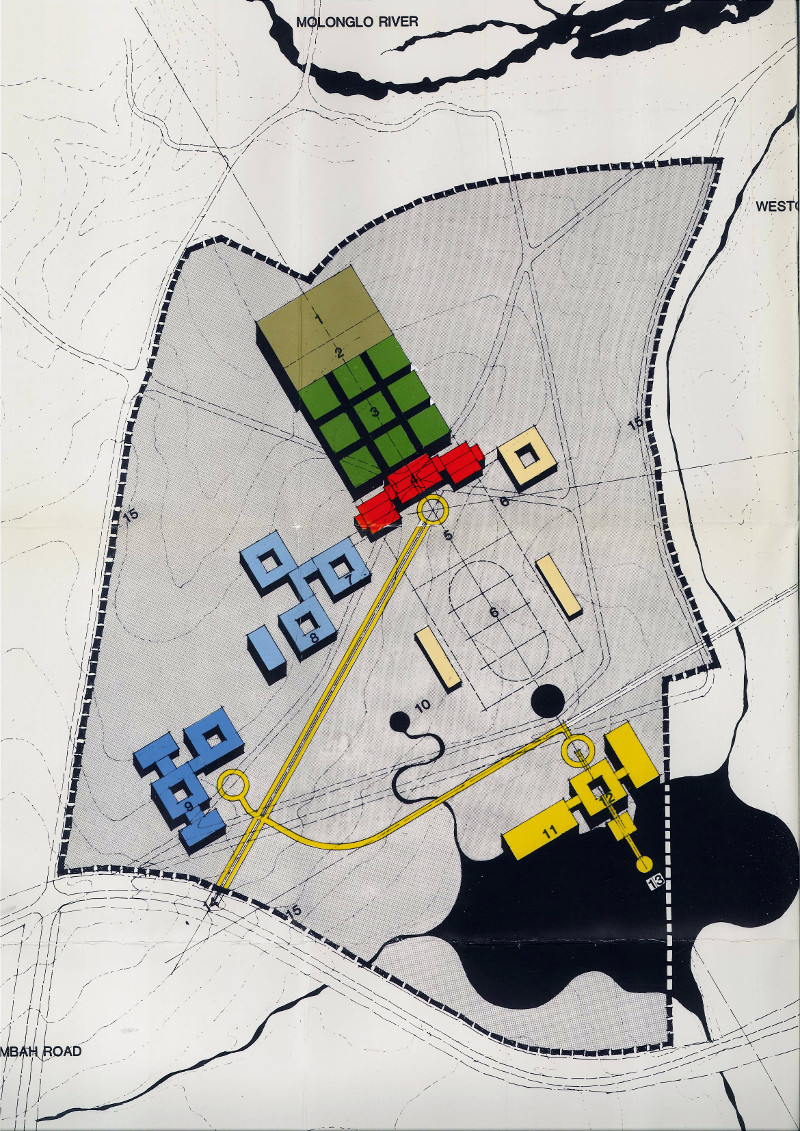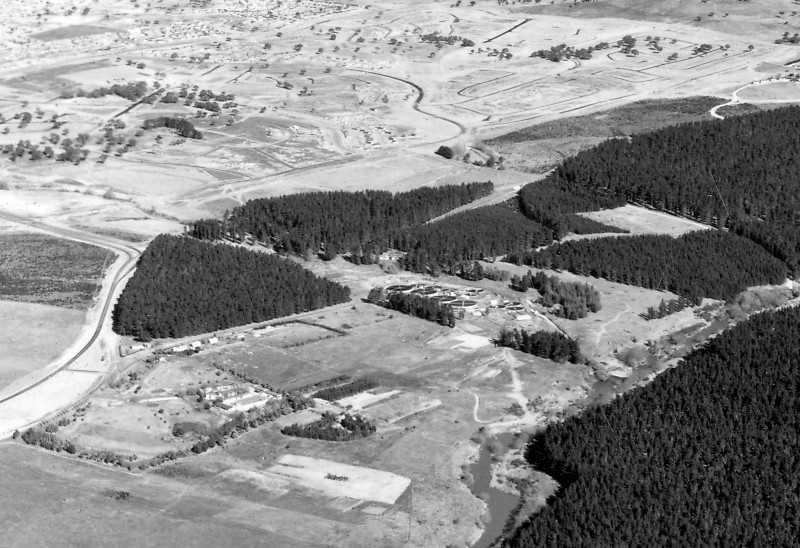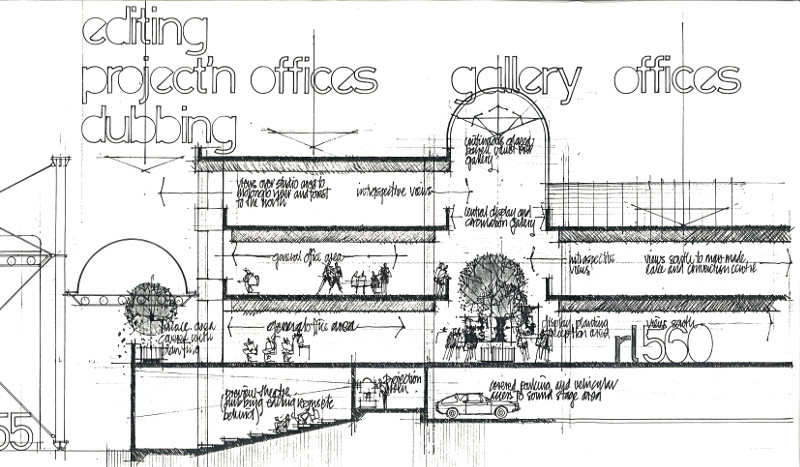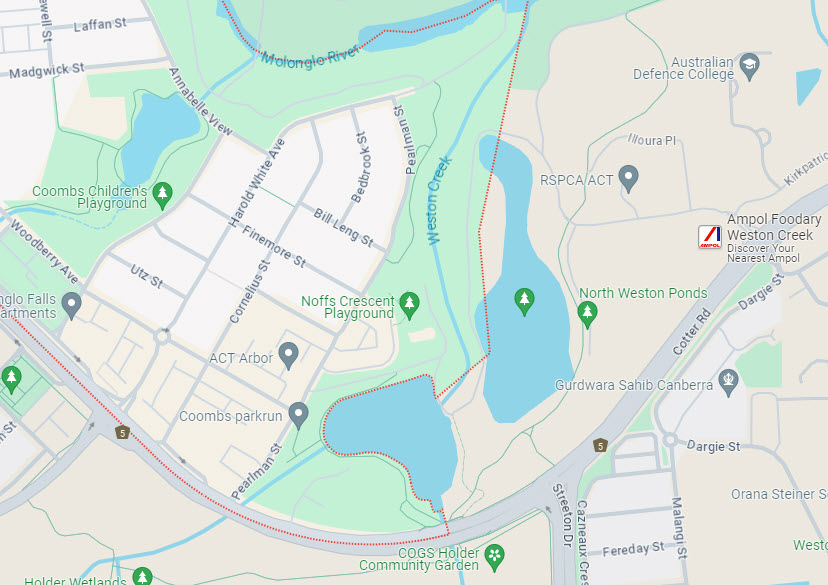
That pond at the bottom right is the only feature of the studio plans that still exists today. Photo: ArchivesACT.
You may not have even noticed them, but there are a couple of artificial ponds at the intersection of Cotter Road and Streeton Drive in the Molonglo Valley.
They’re marked as the North Weston Ponds on Google Maps, but go back 40 years and they were major features in blueprints for a sprawling 65-acre film studio.
Yep, the suburb of Coombs was almost Canberra’s Hollywood.
The idea was nothing new.
Since the nation’s capital was birthed in 1913, several proposals for film studios have come across the Commonwealth Government’s desk.
In 1945, then Minister for Information Arthur Calwell said he wanted Canberra to become “the focal point of the documentary film industry in Australia”.
But things really only became serious in October 1981 when United American & Australasian Film Productions (UAA) approached the Department of Capital Territory (DCT), which was then in charge of the ACT.
Apparently, UAA was impressed by “the lack of air pollution, ease of movement, variety of landscapes and access to other scenery (eg, coastal and mountainous areas)” on offer.
They toured “several areas west of the city, including Pine Island”, but settled on Weston Creek Block 649.
An architect was contracted from Cameron Chisholm & Nichol (CCN) – the same company that already had the design of Belconnen Mall and the National Carillon on its CV.

The Molonglo Valley, circa 1972. Photo: ACT Archives.
On 27 April 1982, the news broke on the $35 million ‘Studio City Canberra’.
“It will be the largest facility of its kind in the Southern Hemisphere, incorporating up to 10 sound stages, production and editing rooms, laboratories, screening and rehearsal rooms, accommodation, convention facilities and the auxiliary requirements associated with filmmaking,” the press release read.
It was hailed as a boost for local jobs, as well as something that would put Australia on the map for international filmmaking.
“UAA believes the time is right for Australia to take advantage of the present demand being created by the American satellite and cable networks and that the future of Australian films has never been brighter.
“In addition, Studio City Canberra’s potential as a tourist attraction will be fully exploited, with the aim of making it one of the nation’s top drawing cards for travellers.”

The studio was to be designed by the same company behind the Belconnen Mall and the National Carillon. Photo: ArchivesACT.
Plans were for construction to commence in 1984.
But a quick look around Coombs today and you’ll notice the only feature that comes close to fame is the Ruth Park Playground (and even then, there are no public toilets available – for the moment, at least).
So what happened to Studio City Canberra?
At the time, the media’s attention was also on ‘Section 10BA’ of the Income Tax Assessment Act. A loophole in this allowed companies to receive up to 150 per cent tax deduction on all funds investing filmmaking, and then effectively a tax holiday on the first 50 per cent return on investment.
The hope was to fast-track Australia’s film industry, and it’s true some big names came out of it, such as The Man from Snowy River (1982), The Year of Living Dangerously (1982), Mad Max 2: The Road Warrior (1981) and Crocodile Dundee (1986).
But also led to money being poured into projects that had no hope of getting up just so investors could enjoy the tax breaks.
However, by February 1985, the DCT hadn’t heard any more about the plans from UAA and had told a National Capital Development Commission (NCDC) inquiry that the “department considers that the application has lapsed”.
UAA continued to fund a number of feature films throughout the 1980s but finally deregistered in 1999.

The Coombs ponds. Photo: Screenshot, Google Maps.
The site of the dream sat as a pine plantation for another 25 years until its gazettal in 2010 as part of Coombs, with only the artificial ponds as a nod to what could have been.
But now, 40 years on, we’re very close to getting our own film studio.
John De Margheriti, founder of the Academy of Interactive Entertainment (AIE), is spending $200 million over the next 20 years to add sound stages, editing suites and virtual production technology – together with accommodation for students and staff of up to 580 people – to the Canberra Technology Park in Watson.
Construction on Stage 1 is expected to start towards the middle of next year, with completion by December 2026.
“Once that first stage is up, we’ll be making films pretty much on an ongoing basis,” he said.
“It’s going to mean hundreds of jobs for Canberra.”
Original Article published by James Coleman on Riotact.

